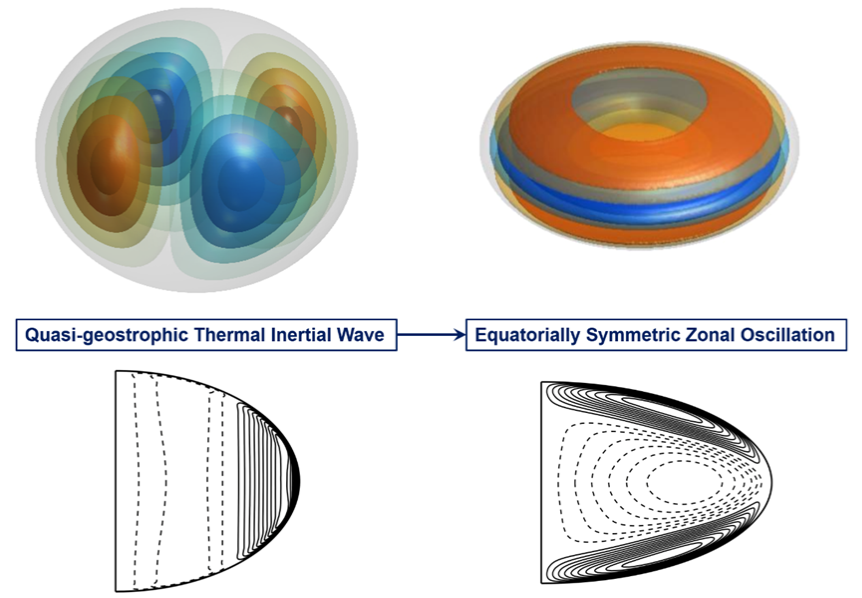Title: Rapidly Rotating, Self-gravitating Geophysical/Astrophysical Fluid: Conduction State, Thermal Instability and Turbulence
Speaker: 孔大力
Institute: 上海天文台
Host: 冯思轶
Time: 2024.4.18 周四 16:00
Location: 物理楼 552
Abstract:
The problem of thermal convections in rapidly rotating, self-gravitating fluid bodies has been widely modeled in spheres or spherical shells, which implicitly neglects the flattening effect due to the centrifugal force. However, the fast rotation of gaseous giant planets and some of Be stars makes them bulge out enough that they can’t be treated as spheres. As a result, investigating the thermal instability and turbulent convection in oblate spheroids will help better understand the convection processes in these planets and stars or even very flattened systems. In recent works, we first derived a nonspherical reference state model in oblate spheroidal geometry whose shape should be determined by the theory of figure (ToF). A closed-form solution was obtained for gravity and temperature (Kong 2022 Phys. Rev. Fluids). Based on this nonspherical conduction state model, the thermal instability problem is formulated in both inertial and viscous convection regimes (Li and Kong 2022 Phys. Rev. Fluids; Li and Kong 2023 Phys. Rev. Fluids; Li and Kong 2024 Phys. Rev. Fluids). The critical properties of inertial modes are explicitly derived. The dependence of the onset of thermal inertial convection on the oblateness of the spheroid is systematically explored. A significant discovery is that the globally most unstable mode could switch from a non-axisymmetric quasi-geostrophic wave to an equatorially symmetric zonal oscillation when the rotational flattening effect gets very strong. This was the only form of global convection not found so far. Stronger nonlinear turbulent dynamics are also explored, and new results imply a new understanding of the formation of mean zonal flow patterns observed on the surfaces of Jupiter and Saturn (Kong and Yuan 2024 Phys. Rev. Fluids).
Bio:
Dr. Dali Kong graduated from the Department of Astronomy, Nanjing University, in 2008 and obtained his Ph.D. in Applied Mathematics from the University of Exeter in 2012. He joined Shanghai Astronomical Observatory in 2017 after spending five years of Postdoc fellowship at the Centre for Geophysical and Astrophysical Fluid Dynamics, University of Exeter. Dr. Kong mainly works in planetary fluid dynamics and is particularly skilled at analyzing the dynamics of rapidly rotating systems.
References:
1. Kong, D. (2022) Rapidly rotating self-gravitating Boussinesq fluid: A nonspherical model of motionless stable stratification, Physical Review Fluids, 7, 074803
2. Li, W., and Kong, D.* (2022) Rapidly rotating self-gravitating Boussinesq fluid. II. Onset of thermal inertial convection in oblate spheroidal cavities, Physical Review Fluids, 7, 103502
3. Li, W., and Kong, D.* (2023) Rapidly rotating self-gravitating Boussinesq fluid. III. A previously unknown zonal oscillation at the onset of rotating convection, Physical Review Fluids (Letter), 8, L011501
4. Li, W., and Kong, D.* (2024) Rapidly rotating self-gravitating Boussinesq fluid. IV. Onset of multimodal thermal convection influenced by oblate spheroidal geometry, Physical Review Fluids, in review
5. Kong, D.* and Yuan, L., Rapidly rotating self-gravitating Boussinesq fluid. V. turbulent convections departing surprisingly from geostrophy due to non-sphericity, submitted
